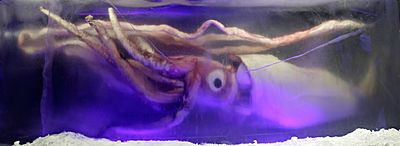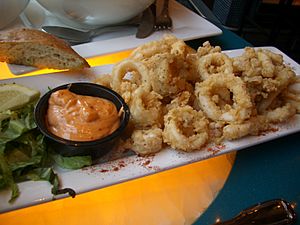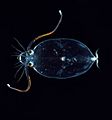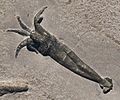Squid facts for kids
Quick facts for kids Squid |
|
|---|---|
 |
|
| Bigfin reef squid, Sepioteuthis lessoniana | |
| Scientific classification | |
| Kingdom: | |
| Phylum: | |
| Class: | |
| Subclass: | |
| Superorder: | |
| Order: |
Teuthida
A. Naef, 1916
|
Squids are amazing ocean animals that belong to a group called cephalopods. This group also includes octopuses and cuttlefish. Squids are meat-eaters, which means they are carnivores. They hunt other animals for food. But squids are also hunted themselves by bigger animals. For example, the biggest squids, like the giant squid and colossal squid, are often eaten by sperm whales and sleeper sharks.
There are about 300 different species of squid living in the world's oceans.
Contents
What Makes a Squid Special?
Squids are a lot like cuttlefish. They have eight arms that come in pairs, and two longer parts called tentacles that have suckers on them.
All squids have a mouth with a special scraping tool called a radula. They also use a method called jet propulsion to move around. They do this by pushing water out of a tube called a siphon, which is part of their mantle (their main body). The radula helps them scrape up food.
Squids use their tentacles to move and to catch their food. Remember, all squids are carnivores, so they only eat other animals, not plants.
Like other cephalopods, squids are very smart animals. They have a clear head area with sense organs and a brain at the front. Even though squids don't have a hard shell on the outside, they do have a small, hidden shell inside their body. This inner shell is made of a material called chitin.
A squid's skin is covered in special cells called chromatophores. These cells let the squid change its color very quickly to match its surroundings. This is how they camouflage themselves, making it hard for predators to see them. Their nervous system controls these color changes in real time, almost like magic!
How Squids Reproduce
After a male and female squid mate, the female squid lays her eggs. The eggs are protected inside an egg case. Squids often live in groups called shoals. Because of this, many squids lay their egg cases together. These cases are then attached to the sea floor. This is why you often find squid eggs in large clumps that can sometimes look like a flower.
Sadly, the male squid usually dies soon after mating. The female squid also dies once she has laid all her eggs. This means that most squids only lay eggs once in their lives. Squids don't live for a very long time. While a few species can live longer, most squids only live for about one or two years.
How Big Can Squids Get?
Most squids are not very big, usually less than 60 centimetres (24 in) long. However, the famous giant squid can grow much larger, sometimes reaching up to 13 metres (43 ft)!
In 1978, something strange happened to the USS Stein, a navy ship. Sharp, curved claws from squid suction cups cut through the rubber coating on the ship's hull. The size of these marks suggested that the squid was one of the largest known at that time.
In February 2007, a fishing boat from New Zealand caught a colossal squid near Antarctica. This amazing squid weighed 495 kilograms (1,091 lb) and was about 10 metres (33 ft) long. It was the largest invertebrate (an animal without a backbone) ever found! Squids also have the biggest eyes of any animal on Earth.
Giant squids are often talked about in stories and old legends. The Kraken is a legendary monster with many tentacles, which might have been inspired by people seeing real giant squids.
Squids and Humans
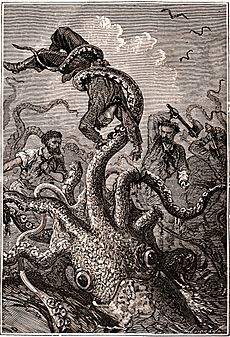
Squids in Stories and Art
Giant squids have been seen as scary monsters of the deep since ancient times. Famous thinkers like Aristotle (who lived in the 300s BC) and Pliny the Elder (who lived in the 1st century AD) wrote about giant squids. Some people think that the Gorgon from Greek mythology (like Medusa with snakes for hair) might have been inspired by squids or octopuses. The six-headed sea monster Scylla from the Odyssey might also have come from similar ideas. And as we mentioned, the old Nordic legend of the kraken probably came from people seeing very large cephalopods.
In more recent stories, H. G. Wells wrote a short story called "The Sea Raiders" about a man-eating squid. The science fiction writer Jules Verne also wrote about a kraken-like monster in his famous 1870 novel Twenty Thousand Leagues Under the Sea.
Squid as Food (Calamari!)
Squid is a popular food all over the world, especially in Japan. In Japan, it's eaten in many ways, like thin strips called ika sōmen, raw as sashimi, or fried as tempura. Several types of squid are commonly eaten, such as L. vulgaris in the Mediterranean Sea (known as Calamar in Spanish and Calamaro in Italian), L. forbesii in the Northeast Atlantic, and L. pealei on the East Coast of America. The Todarodes pacificus is also a very important type of squid for fishing in the North Pacific, caught in places like Canada, Japan, and China.
In English-speaking countries, squid used as food is often called calamari. This word came from Italian in the 1600s. Squids are found in large numbers in some areas, which makes them a great catch for fisheries. The body of the squid can be stuffed whole, cut into flat pieces, or sliced into rings. The arms, tentacles, and even the ink can be eaten! The only parts usually not eaten are the beak and the inner shell (called the gladius or pen). Squid is a good source of important nutrients like zinc, manganese, copper, selenium, vitamin B12, and riboflavin.
Squid Fishing
According to the FAO, a lot of cephalopods were caught in 2002. Out of that total, about 75.8 percent, or 2,189,206 tonnes, were squids! This shows how important squids are for fishing around the world.
Images for kids
-
Fossil Loligosepia aalensis from the lower Jurassic; the ink sac is still full of black eumelanin pigment
-
Hectocotylus of Uroteuthis duvauceli: one tentacle of the male is adapted for transferring the spermatophore
-
The body of glass squids (Cranchiidae) is mainly filled by a transparent coelom containing ammonium ions for buoyancy.
-
A giant squid. The bars are a metre (3 feet) apart.
-
The whip-like tentacles of Mastigoteuthis are covered with tiny suckers to catch small organisms like flypaper
-
Fossil Plesioteuthis from the Tithonian (c. 150 mya, upper Jurassic), Solnhofen, Germany
-
Controllable chromatophores of different colours in the skin of a squid allow it to change its coloration and patterns rapidly, whether for camouflage or signalling.
-
Principle of counter-illumination camouflage of the firefly squid, Watasenia scintillans. When seen from below by a predator, the animal's light helps to match its brightness and colour to the sea surface above.
See also
 In Spanish: Calamar para niños
In Spanish: Calamar para niños



